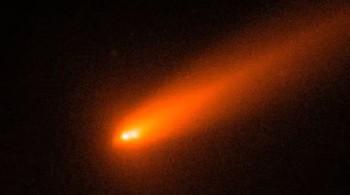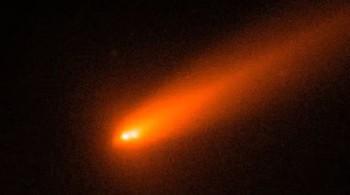
Comet C/2025 K1 (ATLAS) breaks into 3 after coming close to Sun
In a fascinating and rare astronomical event, Comet C/2025 K1 (ATLAS) has broken into three pieces after swinging too close to the Sun. This remarkable occurrence was captured by astronomers using Italy’s Copernicus telescope, providing a unique glimpse into the comet’s fragile structure. The comet’s nucleus became unstable after it passed close to the Sun on October 8, resulting in a spectacular split that has left scientists and space enthusiasts alike in awe.
The breakup of Comet C/2025 K1 (ATLAS) is a significant event, as it provides valuable insights into the composition and behavior of comets. Comets are icy bodies that originate from the outer reaches of the solar system, and their close approaches to the Sun can cause them to break apart due to the intense heat and gravitational forces. In this case, the comet’s proximity to the Sun caused its nucleus to become unstable, leading to a fragmentation that has resulted in three distinct pieces.
The two larger chunks of the comet are estimated to have drifted about 2,000 km from each other, with a smaller third piece visible to the left of the pair. This separation is a result of the comet’s disintegration, which is believed to have occurred due to the Sun’s intense radiation and gravitational forces. The breakup of Comet C/2025 K1 (ATLAS) is a reminder of the dynamic and unpredictable nature of comets, which can change shape and structure rapidly as they approach the Sun.
The observation of Comet C/2025 K1 (ATLAS) was made possible by the Copernicus telescope, a state-of-the-art astronomical instrument located in Italy. The telescope’s advanced technology and high-resolution imaging capabilities allowed scientists to capture stunning images of the comet’s breakup, providing a unique perspective on this rare event. The images show the comet’s nucleus in exquisite detail, with the two larger chunks and the smaller third piece clearly visible.
The breakup of Comet C/2025 K1 (ATLAS) is not only a fascinating astronomical event but also an important opportunity for scientists to study the composition and behavior of comets. By analyzing the comet’s fragments and their trajectories, researchers can gain valuable insights into the comet’s internal structure and the forces that shape its behavior. This knowledge can help scientists better understand the formation and evolution of our solar system, as well as the potential risks and opportunities posed by comets and other near-Earth objects.
Comet C/2025 K1 (ATLAS) is a long-period comet, meaning that it takes more than 200 years to complete one orbit around the Sun. Its discovery was announced in May 2025, and since then, astronomers have been tracking its progress as it approaches the inner solar system. The comet’s close approach to the Sun on October 8 marked a critical moment in its journey, as the intense heat and radiation caused its nucleus to become unstable and eventually break apart.
The observation of Comet C/2025 K1 (ATLAS) is a testament to the power of modern astronomy and the importance of continued exploration and research into our solar system. By studying comets and other celestial objects, scientists can gain a deeper understanding of the universe and its many mysteries, ultimately expanding our knowledge and inspiring future generations of astronomers and space enthusiasts.
In conclusion, the breakup of Comet C/2025 K1 (ATLAS) is a remarkable event that has captivated the imagination of scientists and space enthusiasts around the world. The comet’s fragmentation is a reminder of the dynamic and unpredictable nature of comets, and the importance of continued research and exploration into our solar system. As we continue to study Comet C/2025 K1 (ATLAS) and its fragments, we may uncover new insights into the composition and behavior of comets, ultimately expanding our understanding of the universe and its many wonders.





